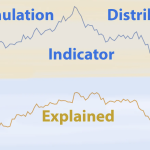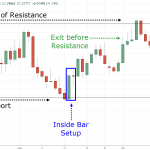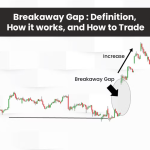
By ATGL
Updated August 27, 2024
The bear pennant pattern is a valuable tool in technical analysis, offering insights into potential downward price movements in financial markets. This guide explores the bear pennant, its identification, trading strategies, and its strengths and limitations.
What Is a Bear Pennant and What Does It Look Like?
A bear pennant is a continuation pattern that typically forms during a strong downtrend. It consists of two main components: a sharp downward move (the flagpole) followed by a consolidation period (the pennant). This pattern suggests that the prevailing downtrend is likely to continue after a brief pause.
The bear pennant resembles a small, symmetrical triangle or pennant shape, hence its name. It’s characterized by converging trendlines that connect the highs and lows during the consolidation period. The pattern is complete when the price breaks below the lower trendline, signaling a potential continuation of the downtrend.
Spotting the Bear Pennant Chart Pattern
Identifying a bear pennant requires attention to several key elements.
Location and Shape
Look for the bear pennant to form after a significant price decline. The flagpole should be a steep, nearly vertical drop in price. The pennant itself appears as a small consolidation pattern, with price action forming a symmetrical triangle or narrow range.
Trading Volume Activity and Trends
Typically, you’ll observe high trading volume during the initial price drop. As the pennant develops, volume tends to decrease, reflecting a period of consolidation. When the price breaks below the lower trendline of the pennant, an increase in volume often confirms the pattern’s completion and the continuation of the downtrend.
Support and Resistance Levels
Pay attention to support and resistance levels when identifying bear pennants. The upper and lower trendlines of the pennant often act as temporary resistance and support levels, respectively. A decisive break below the lower trendline is a critical signal for potential trade entry.
Volatility and Lack of Range Expansion
During the pennant formation, price action typically becomes less volatile, with smaller price swings. This lack of range expansion is characteristic of the consolidation phase. Traders should be alert for a sudden increase in volatility and a break below the pennant, which often signals the pattern’s completion.
Tips on How To Trade Bearish Pennants
To effectively trade bear pennant patterns, consider the following strategies:
- Confirm the trend: Verify that the overall market trend is bearish before considering a bear pennant trade. Use both fundamental and technical analysis to validate the trend.
- Wait for the breakout: Enter a short position when the price breaks below the lower trendline of the pennant, preferably with increased volume.
- Set a stop-loss: Place a stop-loss order slightly above the upper trendline of the pennant to manage risk.
- Determine profit targets: Use the flagpole’s length as a guide for potential profit targets. Many traders project the flagpole’s length from the breakout point to estimate the potential price move.
- Monitor volume: Look for an increase in trading volume as the price breaks below the pennant, which can confirm the pattern’s validity.
- Consider time frames: Bear pennants can form in various time frames. Align your trading strategy with your preferred time horizon.
- Use additional indicators: Complement the bear pennant pattern with other technical indicators like moving averages or momentum oscillators for additional confirmation.
- Manage your risk-reward ratio: Make sure that the potential reward justifies the risk taken on each trade.
- Practice patience: Avoid premature entries. Wait for confirmation of the pattern completion before executing trades.
- Be aware of false breakouts: Sometimes, prices may briefly break below the pennant before reversing. Use price action and volume analysis to distinguish between true and false breakouts.
Strengths and Limitations of This Trading Pattern
As with any technical analysis tool, the bear pennant is not a guaranteed predictor of market movements. Instead, it’s a probabilistic indicator that can inform trading decisions when used correctly. Recognizing its advantages and drawbacks will help you incorporate this pattern more effectively into your overall trading approach.
Strengths:
- Clear visual pattern: The bear pennant is relatively easy to identify on price charts.
- Provides specific entry and exit points: The pattern offers clear signals for trade entry and stop-loss placement.
- Applicable across markets: Bear pennants can be found in various financial markets, including stocks, forex, and commodities.
- Offers profit target estimation: The flagpole’s length provides a basis for setting realistic profit objectives.
- Integrates well with other analysis tools: The bear pennant complements other technical analysis techniques and fundamental analysis.
Limitations:
- Not foolproof: Like all technical patterns, bear pennants are not 100% reliable and can result in false signals.
- Subjective interpretation: Traders may disagree on the exact boundaries of the pattern, leading to different trade decisions.
- Requires confirmation: The pattern’s reliability increases when confirmed by other technical indicators and market factors.
- Market context dependency: Bear pennants may be less effective in strongly bullish markets or during periods of low volatility.
- Potential for premature signals: False breakouts can occur, leading to losses if not properly managed.
Successful trading often involves combining multiple analysis techniques and maintaining a disciplined risk management strategy rather than relying solely on any single pattern or indicator.
Take Your Trading Skills to the Next Level With Above the Green Line
Mastering the bear pennant pattern can significantly bolster your trading toolkit, especially in bearish market conditions. However, successful trading requires more than just pattern recognition. It demands a comprehensive understanding of market dynamics, risk management, and continuous learning.
To further develop your trading skills and gain access to expert insights, consider joining Above the Green Line’s membership program. Our platform offers advanced trading education, real-time market analysis, and a community of experienced traders to support your journey. By combining the power of technical patterns like the bear pennant with a robust trading education, you can navigate the complexities of financial markets and potentially improve your trading outcomes.






